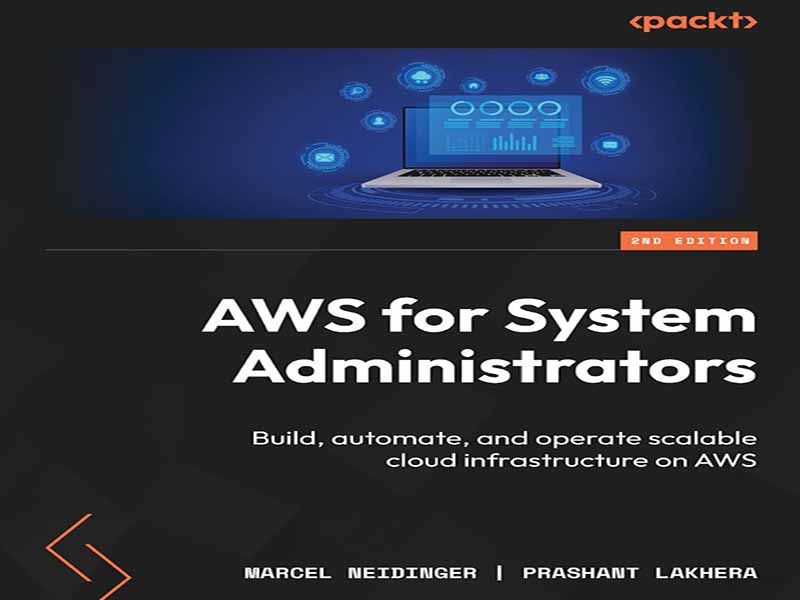- عنوان کتاب: AWS for System Administrators, Second Edition Build, automate, and operate scalable cloud infrastructure on AWS
- نویسنده: Marcel Neidinger
- حوزه: پلتفورم ابر آمازون
- سال انتشار: 2025
- تعداد صفحه: 427
- زبان اصلی: انگلیسی
- نوع فایل: pdf
- حجم فایل: 11.4 مگابایت
به دنیای جذاب عملیات سیستمها – یا SysOps – در AWS خوش آمدید. کتاب AWS برای مدیران سیستم، ویرایش دوم، مقدمهای بر استقرار، خودکارسازی و مدیریت بارهای کاری در AWS است. این کتاب در طول ۱۷ فصل خود، ابزارها و تکنیکهای مورد نیاز برای مدیریت بارهای کاری در فضای ابری را به شما معرفی میکند. پس از اتمام این کتاب، دنیای محاسبات مقیاسپذیر را کاوش خواهید کرد، یاد خواهید گرفت که چگونه استقرار پایگاههای داده رابطهای را خودکارسازی کنید، یک سازمان چندحسابی راهاندازی کنید و موارد بسیار دیگری را انجام دهید. در سراسر کتاب، نمونههای عملی از خودکارسازی استقرار این اجزای زیرساخت را از طریق استفاده از ابزارهای Infrastructure-as-Code مانند Terraform یا CloudFormation مشاهده خواهید کرد. شما راهنماییهای معماری و توضیحاتی در مورد مفاهیم اصلی بارهای کاری عملیاتی در AWS دریافت خواهید کرد. این کتاب برای متخصصان فناوری با تجربه اولیه در فضای ابری طراحی شده است که قصد دارند نحوه خودکارسازی و مدیریت سیستمهای نرمافزاری و زیرساختهای اساسی آنها را در AWS درک کنند. چه مدیر سیستم، مهندس DevOps یا معمار راهحل باشید و به دنبال بهرهبرداری حداکثری از AWS، این کتاب به شما این امکان را میدهد که چالشها و راهحلهای مربوط به اجرای برنامهها در AWS را بهتر درک کنید. درک اولیه از مفاهیم و سرویسهای ابری در AWS و همچنین آشنایی با ابزارهای فناوری اطلاعات مانند Git و Terraform و یک زبان برنامهنویسی مانند پایتون توصیه میشود. اما اگر این پیشنیازها را ندارید، کتاب توضیحاتی را ارائه میدهد تا شما را با این مفاهیم آشنا کند. از این کتاب برای شروع سفر خود به سمت تبدیل شدن به یک اپراتور سیستم در AWS استفاده کنید! فصل 1، راهاندازی محیط AWS، شما را با اصول اولیه راهاندازی یک حساب کاربری در AWS و همچنین ابزارهای Infrastructure-as-Code (IaC) که در سراسر این کتاب استفاده خواهیم کرد، آشنا میکند: Terraform، CloudFormation و AWS Cloud Development Kit (CDK). فصل 2، محافظت از حساب AWS شما با استفاده از IAM، مفاهیم سرویس مدیریت هویت و دسترسی (IAM) را که در سراسر AWS برای احراز هویت و مجوز استفاده میشود، توضیح میدهد. فصل ۳، ایجاد یک مرکز داده در ابر با استفاده از VPC، مفاهیم اولیه شبکهسازی ابر خصوصی مجازی (VPC) – مرکز داده شما در AWS – را پوشش میدهد. فصل ۴، ظرفیت محاسباتی مقیاسپذیر در ابر از طریق EC2، به مفاهیم ابر محاسباتی الاستیک (EC2) – سرویس AWS برای ارائه ماشینهای مجازی در AWS – میپردازد. فصل ۵، افزایش تحملپذیری خطا و کارایی برنامه با متعادلسازی بار الاستیک، توضیح میدهد که چگونه میتوانیم از متعادلسازی بار الاستیک (ELB) برای مسیریابی ترافیک بین چندین نمونه برای افزایش تحملپذیری خطا و کارایی استفاده کنیم. فصل ۶، افزایش عملکرد برنامه با استفاده از مقیاسبندی خودکار AWS، نحوه استفاده از گروههای مقیاسبندی خودکار در AWS را برای مقیاسبندی خودکار محاسبات خود به بالا یا پایین پوشش میدهد. فصل ۷، مقیاسبندی یک پایگاه داده رابطهای در ابر با استفاده از سرویس پایگاه داده رابطهای آمازون (RDS)، نحوه استقرار یک پایگاه داده متنباز Postgres را با استفاده از سرویس پایگاه داده رابطهای آمازون (RDS) توضیح میدهد و مفهوم خدمات مدیریتشده را بررسی میکند. فصل ۸، مدیریت اسرار و کلیدهای رمزگذاری با AWS Secrets Manager و KMS، به شما نحوه مدیریت اسراری مانند رمزهای عبور یا توکنهای دسترسی و همچنین مفاهیم اولیه رمزگذاری در ابر را آموزش میدهد. فصل ۹، ثبت و نظارت متمرکز با Amazon CloudWatch، توضیح میدهد که چگونه میتوانید از CloudWatch و SNS برای ثبت متمرکز وقایع، معیارها و هشدار در AWS استفاده کنید. فصل ۱۰، متمرکز کردن راهحلهای پشتیبانگیری ابری، پشتیبانگیری AWS و نحوه استفاده از این سرویس برای پیادهسازی برنامههای پشتیبانگیری را توضیح میدهد. فصل ۱۱، گزینههای بازیابی فاجعه با AWS، گزینههای مختلف موجود برای معماری برنامههای انعطافپذیر در AWS را بررسی میکند. این فصل همچنین مفاهیم کلیدی هدف زمان بازیابی (RTO) و هدف نقطه بازیابی (RPO) را توضیح میدهد. فصل ۱۲، آزمایش تابآوری زیرساخت و معماری شما با سرویس تزریق خطای AWS، شما را با مهندسی آشوب و سرویس تزریق خطای AWS (FIS) آشنا میکند – سرویسی که به شما امکان میدهد خرابیها را به برنامههای مستقر در AWS خود تزریق کنید تا توانایی آنها را در مقاومت در برابر چنین خرابیهایی هنگام وقوع در تولید آزمایش کنید. فصل ۱۳، استقرار زیرساخت با استفاده از خطوط لوله CI/CD، موضوع راهاندازی خودکار زیرساخت بر اساس کد IaC که در سیستم کنترل نسخه git ذخیره میشود را پوشش میدهد. فصل ۱۴، ساخت اجزای زیرساخت به عنوان کد قابل استفاده مجدد، الگوها و بهترین شیوهها را هنگام ساخت اجزای قابل استفاده مجدد برای تیمهای شما برای مقیاسبندی استفاده از IaC پوشش میدهد. فصل ۱۵، اطمینان از انطباق با استفاده از پیکربندی AWS و SCPها، دو روش مختلف، یک روش پیشگیرانه و یک روش واکنشی، را برای مسدود کردن یا تشخیص ایجاد زیرساختی که با مجموعه قوانین و الزامات شما مطابقت ندارد، معرفی میکند. فصل ۱۶، عملیات در یک محیط چند حساب کاربری، سازمانهای AWS را به عنوان راهی برای راهاندازی چندین حساب AWS که معمولاً هنگام اجرای یک برنامه دنیای واقعی در ابر مورد نیاز است، معرفی میکند. فصل ۱۷، استقرار سرتاسری…
Welcome to the fascinating world of systems operations – or SysOps – in AWS. AWS for System Administrators, Second Edition is your introduction to deploying, automating, and operating workloads in AWS. Over its 17 chapters, this book introduces you to the tools and techniques required to operate workloads in the cloud. After finishing this book, you’ll have explored the world of scalable compute, learned how to automate the deployment of relational databases, set up a multi-account organization, and much more. Throughout the book, you’ll see hands-on examples of automating the deployment of these infrastructure components through the use of Infrastructure-as-Code tools such as Terraform or CloudFormation. You’ll get architectural guidance and explanations for the central concepts of operating workloads within AWS. This book is designed for technology professionals with some basic cloud experience who aim to understand how to automate and operate software systems and their underlying infrastructure on AWS. Whether you are a systems administrator, DevOps engineer, or solutions architect looking into getting the most out of AWS, this book will enable you to better understand the challenges and the solutions involved when running applications on AWS. A basic understanding of cloud concepts and services within AWS as well as some familiarity with IT tools such as Git and Terraform and a programming language such as Python is recommended. But if you don’t have these prerequisites, the book offers explanations to bring you up to speed on these concepts. Use this book to get started on your journey to becoming a systems operator on AWS! Chapter 1, Setting Up the AWS Environment, introduces you to the basics of setting up an account on AWS as well as the Infrastructure-as-Code (IaC) tools we’ll use throughout this book: Terraform, CloudFormation, and AWS Cloud Development Kit (CDK). Chapter 2, Protecting Your AWS Account Using IAM, explains the concepts of the Identity and Access Management (IAM) service that is used throughout AWS for authentication and authorization. Chapter 3, Creating a Data Center in the Cloud Using a VPC, covers the basic networking concepts of the virtual private cloud (VPC) – your data center in AWS. Chapter 4, Scalable Compute Capacity in the Cloud via EC2, looks at concepts of Elastic Compute Cloud (EC2) – the AWS service to provision virtual machines within AWS. Chapter 5, Increasing Application Fault-Tolerance and Efficiency with Elastic Load Balancing, explains how we can use Elastic Load Balancing (ELB) to route traffic between multiple instances to increase fault-tolerance and efficiency. Chapter 6, Increasing Application Performance Using AWS Auto Scaling, covers how we can use Auto Scaling Groups in AWS to automatically scale our compute up or down. Chapter 7, Scaling a Relational Database in the Cloud Using Amazon Relational Database Service (RDS), explains how to deploy an open source Postgres database using the Amazon Relational Database Service (RDS) and explores the concept of managed services. Chapter 8, Managing Secrets and Encryption Keys with AWS Secrets Manager and KMS, teaches you how to handle secrets such as passwords or access tokens as well as the basic concepts of encryption in the cloud. Chapter 9, Centralized Logging and Monitoring with Amazon CloudWatch, explains how you can use CloudWatch and SNS for centralized logging, metrics, and alerting on AWS. Chapter 10, Centralizing Cloud Backup Solutions, explains AWS Backup and how you can use this service to implement backup plans. Chapter 11, Disaster Recovery Options with AWS, explores the different options available to architect resilient applications on AWS. The chapter also explains the key concepts of Recovery Time Objective (RTO) and Recovery Point Objective (RPO). Chapter 12, Testing the Resilience of Your Infrastructure and Architecture with AWS Fault Injection Service, introduces you to chaos engineering and AWS Fault Injection Service (FIS) – a service that lets you inject failures into your AWS-deployed applications to test their ability to withstand such failures when they happen in production. Chapter 13, Deploying Infrastructure Using CI/CD Pipelines, covers the topic of automated infrastructure rollout based on IaC code that is stored in the version control system git. Chapter 14, Building Reusable Infrastructure-as-Code Components, covers patterns and best practices when building reusable components for your teams to scale IaC usage. Chapter 15, Ensuring Compliance Using AWS Config and SCPs, introduces two different methods, a proactive and reactive way, to block or detect the creation of infrastructure that is non-compliant with your set of rules and requirements. Chapter 16, Operating in a Multi-Account Environment, introduces AWS Organizations as a way to set up the multiple AWS accounts usually required when operating a real-world application in the cloud. Chapter 17, End-to-End Deployment of an Application, uses the tools, techniques, and concepts learned throughout the book to cover the end-to-end deployment of an application. From account setup to deployment pipeline and fault testing, this chapter shows how all the concepts introduced throughout this book fit together.
این کتاب را میتوانید از لینک زیر بصورت رایگان دانلود کنید:




































نظرات کاربران